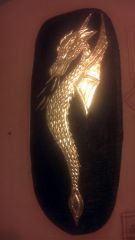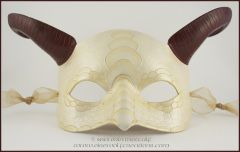-
Posts
900 -
Joined
-
Last visited
Content Type
Profiles
Forums
Events
Blogs
Gallery
Everything posted by WinterBear
-

Another Way To Kill An Evening
WinterBear replied to Suicide's topic in Purses, Wallets, Belts and Miscellaneous Pocket Items
Not everything was beaded though, so there is nothing wrong with your bags not having beads! Beaded stuff was often reserved for special occasions. Your bags look pretty good actually, and would be cheerfully carried by a lot of the people around here. Before they had glass and brass trade beads, they would use bones, antlers, claws, hoof tips, teeth, stones, wood, feathers, leather fringe, fur, and seeds to make beads and trims. I've seen some very nice old beads made from sawn sections of small bones alternating with claws and sections of quills, for instance--it made a very unusual necklace. Paints, and/or incised or burned lines and patterns were also used for decoration on items where beads, fringe, or fur would get damaged or soiled. So, don't get hung up on your item not having beads. -
Ok, somebody clue me in. What's a jinx cat?
-
Looks really nice, I especially like your style of lettering.
-
Hi Colby. I would recommend the book "How to BuckStitch" by Al Stohlman. You can buy the book at Tandy or off of Amazon, or purchase a digital download from the Tandy Leathercraft Library (it's even on sale). http://www.leathercraftlibrary.com/p-1137-how-to-buckstitch-by-al-stohlman.aspx The book explains how to buckstitch, punch the slits, how the lace should look, and how to splice if the lace is too short or breaks. There are lots of diagrams that clarify the instructions, and a few patterns in the book as a bonus.
-
I'll message you my info, and complete the PayPal payment for all 5+postage either late tonight after I get home from Scouts or tomorrow morning before work.
-
I would like to inquire if these are still available? 2940 2140 4060 4110? --can't quite read the number--the floral? 4030
-
I was really sorry to hear about this. My condolences to his family and his friends.
-

February 2012 Challenge
WinterBear replied to chancey77's topic in Special Events, Contests and Classes
Hi Chancey, It's not a lack of wanting to do it. My problem is I am not where I can make anything. I'm not at home, where all of my tools and leather are. -

Hatband
WinterBear replied to Leatherimages's topic in Purses, Wallets, Belts and Miscellaneous Pocket Items
I have family all over New Mexico, Wyoming, and the Dakotas. Turquoise and black is definitely not out of style here! Love the squash blossom necklaces, heishei, old pawn, Kingsman and Sleeping Beauty turquoise (especially if it is old and natural--not the stabilized or reconstituted chalk stuff). Maybe that's why I find this so appealing. -

Hatband
WinterBear replied to Leatherimages's topic in Purses, Wallets, Belts and Miscellaneous Pocket Items
That would turn heads around here, they love cowboy hats and hatbands, especially the rodeo crowd. I really like the overall style of this, and learning that the feathers were out of leather too just impressed me all the more. -
#4 looks like it might also be from a push beader, such as what Barry King has? http://www.barrykingtools.com/handtools.htm
-
I know they sell crap. The thing is, I'm not adverse to buying crap until I hone my skills enough to need and want better. I don't have those skills yet, and won't for some time. If I can manage to make a product with crap that doesn't want to make me chuck it out the window in disgust, then I have learned enough to invest money in something better. And if I'm working with a bunch of kids who damage a tool, I won't be upset because the cost wasn't much and I can have it mended, resharpened, or replaced before the next time it is needed.
-
Tandy caters to an entirely different clientele than most leather stores anymore. From talking to a lot of people, who like myself, buy from Tandy, Tandy's base has become more specialized as interest in hobbies and crafting has declined and internet sales have become so much more prevalent. Their base for the most part seems to be kids and the small, locally-run camps and youth events (rather than district events); micro-makers who probably don't use an entire hide in a year; those just getting their feet wet in learning the craft; and those who can't or won't spend a lot on investing in tools, or purchasing more hide, in quantity or quality, than they need. A lot us don't have wholesale licenses either, so that automatically excludes us from the wholesale pricing at other suppliers. Wholesale license cost varies by state too. The last time I looked into this, just to have the necessary permits and licenses for me to legally buy materials at wholesale cost and then sell the completed items online, at a flea market, or whatever, the cost was around $500. That knocks wholesale licensing right out of the ballpark for a lot of people. With the economy being what it is, a lot of people just can't flat out afford a whole top grade hide and terrific tools, even if they did have a wholesale license.They might have enough to buy some kits and a few tools they won't mind their kids beating up, just so they can dabble and maybe pry the kids away from the TV, or be retired and just want to be able to afford make a few things for themselves, enjoy time with a hobby, and still keep to their budget. In addition, for a lot of us, the Tandy is local, which saves a lot of money for us in this area because shipping to the backwaters of the Rockies can account for a considerable amount when shipping large items (such as a box of hide--unless you are buying several sides, the cost of shipping added to the cost of an economy-grade hide is often more than what you can pay for a better and bigger piece of hide at Tandy). Lastly, from everything that I have heard, kids' exposure to leatherwork is being significantly affected by the economy and the move away from handcrafts since the 70s and 80s--the schools, camps, after-school programs, youth clubs, and churches in some instances have gotten rid of their tools and have no intention of replacing the programs. Some kids are only getting the opportunity now because someone bought a few tools at a time, paying out of their own pockets (so they bought what they can afford). Since they could either afford one or two quality stamps or a dozen or more cheap stamps at a time, Tandy cheap wins out. Then someone brings stamps and tools to the Cub Scout Day Camp and lets the boys make neckerchief slides with their den logo or name stamped on it, or a Scout Patrol meets at such-and-such's garage to make tooled knife sheathes and billfolds some Saturday to fill the requirements for the merit badge, or a bunch of kids meet in someone's basement or at the Boys and Girls Club to make bracelets, coasters, or barrettes with the borrowed tools. Having Tandy tools and hide is often the first experience any of the kids have with making anything with leather, and while "low" grade, these kids wouldn't have otherwise had the experience. All in all, I take Tandy's prices with a grain of salt and buy what tools and hide I need for now as I learn, and replace with other brands and other leathers as I gain experience. I'll buy the licenses and permits I need as soon as possible, and maybe make the jump into selling on etsy or at the Holiday markets, and maybe eventually be able to recoup the costs of all of those fees by purchasing wholesale hides and tools.
-

Medieval Leather Case For Book
WinterBear replied to Mrs Barry Hicks's topic in Historical Reenactment
That is really neat, what a fascinating item. I had no idea such book cases existed. I have questions? What is the figure (yourself I presume?) holding in its right hand? Also, are the channels on the side meant to have a cord passed through to hold and carry it (rather like a Japanese inro)? What kind of cord would you use? I'm guessing probably not leather, otherwise you would have had it on the item for the judging, I guess? -
Wow, look at all of the bird slings! Mind if I pick your noodle at some point? I'm working on making one for my boss for his birthday in my spare (HA!) time.
-
Thanks Pete. What a great idea. I'll have to see if the VA here is in the program.
-

Verdigris Forming On New Oak-Tanned Leather
WinterBear replied to Toadflax's topic in Leatherwork Conversation
You might try hardware supply stores or art stores and see if they have a spray-on lacquer. It might seal your current buckles enough that they can be used up until you can get youself better stock. -

Small Satchel
WinterBear replied to AndyL1's topic in Purses, Wallets, Belts and Miscellaneous Pocket Items
That's a great bag, love the style and the details. And best of all, he won't have to worry about the nylon jobbers most people have giving way and dumping a pricey pump onto the sidewalk. -

Verdigris Forming On New Oak-Tanned Leather
WinterBear replied to Toadflax's topic in Leatherwork Conversation
Is your brass unsealed? Most brass is lacquered to prevent corrosion and tarnish. It could be that your brass buckle is not, or the lacquer coat is too thin, and the buckle is reacting with the acidity in the leather. -
hectron, think of a clicker die as a cookie cutter for leather, especially a thick leather, or where you want a lot of exact replicas (boot soles, key fobs, holster and handbag parts, etc.). A clicker press is what presses the die through the leather.
-
Best thing about paracord is that it can be unknotted if you made a mistake. That and the dogs aren't much interested in it. Cats, on the other hand. They tend to not care so much for the rawhide (the "ew, ick" face when a cat grabs a wet rawhide string is hilarious), but I can't work with a piece of paracord without stopping to remove a passing hairball. They come out of the woodwork to pounce, even cats I've never seen before! I'll add that book to my wishlist, thanks!
-
-

Scaled Ram's Horn Wedding Dragon Mask by Eirewolf
WinterBear commented on Eirewolf's gallery image in Our Leatherwork Galleries
-
Thanks for the info WyomingSlick. I'd like to begin buying some of the older tools, but have been generally hesitant about making the ebay plunge. I'm waiting on two Craftool stamps, both pre-USA, I've just purchased from ebay, so I'm now really looking forward to seeing how much better they are than the Tandy ones I bought for my Scouts.




